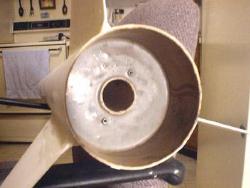| Construction Rating: | starstarstarstarstar_border |
| Flight Rating: | starstarstarstarstar |
| Overall Rating: | starstarstarstar_borderstar_border |
| Diameter: | 4.00 inches |
| Manufacturer: | Aerotech  |
| Style: | Sport |
 Brief:
Brief:
Aerotech's 4", G-powered, parachute recovered rocket using their proprietary LABYRINTH ejection baffle system.
Construction:
Pros: Big (for Aerotech) Easy to build, very nice flyer
Cons: Limited recommended motor range. Very thin fins. Pricy.
Being my first 4" kit, my first impression was WOW! There's something very nice about being able to get your hands into the airframe to work. All the parts listed in the instructions were present, even an extra centering ring. Everything fit nicely with the possible exception of a very tight tube couple. A little sanding brought that little annoyance into line.
A few basics about the kit: It has two 4" tubes. The tubes are fairly sturdy and the spirals are pretty shallow. The coupler fit nicely (if not a little too snug). The nose cone is an old plastic ACE nose cone. It has two standard Aerotech 3/16" square plastic lugs. 1/4" lugs would have been nice and probably should be upgraded. Not really sure what the centering rings are made from. Aerotech has their own name for the material, but they feel like a partial/slate composite. They are very sturdy. The elastic shock cord is about 12' long. I was a little concerned about it being elastic, but it worked without a hitch. The shock cord attaches to the top of the Labyrinth baffle like all the other Aerotech kits and the other end attaches to an eye hook in the bulkhead in the upper section.
The instruction were clear and concise for the most part. (although a couple of times I had to re-read a step to make sure I understood what they were talking about. They had clear illustrations for most the steps that made it very clear from a visual stand point. I didn't use any new construction techniques with this rocket that I haven't done before with the exception of only using epoxy. I didn't bother using CA in areas that they said to use it. System 3 epoxy worked fantastic.
 As designed, on G motors, flights were a lot of fun! Slow take off and low altitude are a lot of fun for me so flying this rocket on G's was a blast. I realized very early on that I didn't want to limit this bird to only G motors. I decided that this was also going to be my cert rocketry to qualify level 1. Modifications were going to have to be made. I used the "bonus" centering ring to add Kaplow Klips and left out the motor clip and motor block. I used only System3 epoxy to glue everything (quite liberally I might add). I will also glass the pathetically thin fins for the H and above flights.
As designed, on G motors, flights were a lot of fun! Slow take off and low altitude are a lot of fun for me so flying this rocket on G's was a blast. I realized very early on that I didn't want to limit this bird to only G motors. I decided that this was also going to be my cert rocketry to qualify level 1. Modifications were going to have to be made. I used the "bonus" centering ring to add Kaplow Klips and left out the motor clip and motor block. I used only System3 epoxy to glue everything (quite liberally I might add). I will also glass the pathetically thin fins for the H and above flights.
Finishing:
Mine is not finished yet, but I wanted a unique look, so I am not going to go with the recommended paint and decal scheme. The decals are the usual self adhesive decals that AT uses on all their kits.
Construction Rating: 4 out of 5
 Flight:
Flight:
Built stock, it flies only on G's, but it fly's as designed on them rather well. I have only flown mine on G64-4's so far and have not had a single problem. It was very stable, even in high winds (20mph). No weather-cocking at all, no coning or spiraling, no problems at all. In fact, in the 20mph+ winds, it didn't cock into the wind at all. The wind actually gently pushed it. On the video tape, the only effect of wind you see is the smoke from the motor going quickly down range. The rocket didn't even seem to notice it at all.
5/00 Update:I successfully used the G-Force in this review (with some modifications) to get my Level 1 certification. It was fairly heavy when I was done modifying it (4lbs fully loaded), but flew perfectly on an H128. The Missile Works RRc2 told me it hit 666 feet on a gusty and pretty windy day.
Recovery:
AT used their ever-popular "boing cord" shock cord. It worked well even though I was concerned. I will modify it even further by adding bunched up tubular nylon around the elastic for insurance. The 36" parachute brought it down rather slowly. In the high winds, I had about a 3/4 mile walk to retrieve it.
Flight Rating: 5 out of 5
Summary:
When built stock, this is a really fun bird to build and fly. It has one really bad drawback that kept it's overall rating down in my eyes. It's price. If the cash doesn't matter to you, then this is a great rocket to have in your collection, but keep in mind that it's not "the only fish in the sea".
Overall Rating: 3 out of 5
Other Reviews
- Aerotech G-Force By Ryan Chavis (August 5, 2016)
Great flight for my L1 cert launch! Flies slow and smooth, lots of fun! Overall Rating: 5
- Aerotech G-Force By Kyle Cornelius
Large mid power model for low altitude flights. Very good materials except the coupler which needs to be beefed up Very quick assembly with major problems in construction. The instructions were pretty straightforward. The fins could be sturdier, but I have flown this rocket 10+ times with only a cracked joint. Very good major components. Finishing: Easy to finish, except for its size, ...
- Aerotech G-Force By Darwin May
Brief: The G-Force is a single staged, parachute recovered large model rocket. There were 2 4" body tubes that were made out of the AT tubing. I opted to design the rocket for a payload by not gluing the nose. It has 3 fins made of EXTREMELY thin plastic that look just like the Sumo fins. The motor mount was 24" by my best guess, and made from thick cardboard. The shock cord appears to be 12' ...
- Aerotech G-Force By David Kneble
This is a great mid-power flyer with two downsides, limited range of motors, high price. All the normal components: Two 4" tubes, an ACE nosecone, 42" parachute, bulkhead equipment, motor tube, CR's, baffle system, elastic 12' shock cord, fins. Instructions are very simple if you have built any other Aerotech kits. If not, then read through them and make sure you understand them. If you ...
 |
 |
Flights
 |
 |
D.B.Jr (January 14, 2002)
D.J.D. (February 1, 2002)
K.D. (July 5, 2004)
Sponsored Ads
 |
 |












S.R. (July 1, 2000)